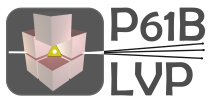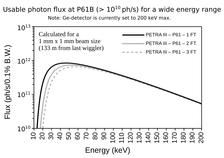Location of beamline P61 and end station P61B in the Paul P. Ewald hall.

The Large Volume Press (LVP) extreme conditions station uses synchrotron X-ray radiation in a continuous energy range of 30 - 160 keV (although photons with higher energies are produced). The station is designed for the combination of ED-XRD and Radiography Imaging techniques. The structure and properties of samples can be measured in situ using these techniques under extreme conditions of high pressures and temperatures. Various anvil combinations and additional cell assembly set ups are available and being developed.
...updated on 2025.05.26
Application of high load and temperature may cause WC anvils to break, resulting in a shock to the press stages and a blow out of materials. We continue to update the beamline operations policy as necessary to minimise this risk and avoid damage to the detector system, diamond exit window, anvils in the LVP and LVP stages.
Please follow the defined rules below to ensure your beamtime is not interrupted:
- During heating or deformation, someone must be present in the CH. (Unattended compression and decompression is permitted)
- UHP experiments (> 30 GPa) MUST use a graphite or aluminium plate attached to the diamond exit window; to shield it from blow-out shrapnel.
- It is not permitted to increase the press load significantly beyond the sample pressure described in the proposal, and recognize when pressure generation becomes inefficient. In such cases, do NOT increase the load further.
- Always enter a complete pressure profile for the master ram with an up-ramp, a dwell, and a down-ramp, to ensure the PLC is in control of the rams at all times.
Should a blow out occur during a normal experiment, this is not a problem! Your local contact will assess the situation and solve any issues that may have occured (e.g. lost reference to the Z-stage). Be mindful that some beamtime may be lost after a blowout.

Announcements
News:
• The next call for proposals is 1 Sept. 2026! Plan accordingly.
• Note, the guest house is usually fully booked, register early.
Call for proposals:
Regular proposals: CLOSED (deadline: - )
Long Term Proposals: CLOSED (deadline: - )
Offline LVP proposals: OPEN (see below)
Meetings:
• EHPRG, Montpellier (France) (23 - 28 Aug 2026)
• SNI conference, Hamburg (Germany) (08 - 10 Sept 2026)
Annual P61B workshop at the DESY User Meetings:
• Due to user operation, no workshop is planned for 2026.
• Visit Beamline talks and posters.

Apply for offline LVP experiments
↦ Submit a project proposal for offline experiments in the LVP for up to 5 days and one or multiple visits during the available periods below.
Note: Applications must be submitted at least one month prior to your planned visit.
Available periods:
- 08 - 12 Dec 2025
- 16 - 27 Feb 2026
- 02 - 25 March 2026
Key considerations:
1. Generally no user support on weekends.
2. Availability of dates is subject to school holidays and beamline maintenance during shutdown periods

Apply for benchtop XRD
↦ Apply for the use of the beamline benchtop X-ray diffractometer. Applications can be submitted any time.
Status:
The diffractometer is available for booking.

Apply for vacuum furnace
↦ Apply for the use of the beamline vacuum furnace. Applications can be submitted any time.
Status:
The vacuum furnace is available for booking.

The BMBF funded the project 05K16WC2 Aster-15 LVP, titled "Erweiterung der Druckbereiche der In-Situ-Röntgenbeobachtung mit der Großvolumen-Hochdruckapparatur an der PETRA-III-Extension des Deutschen Elektronen-Synchrotrons DESY" from University Bayreuth (T. Katsura).










